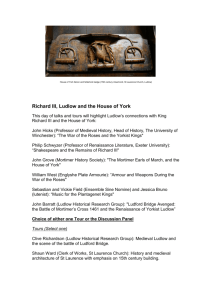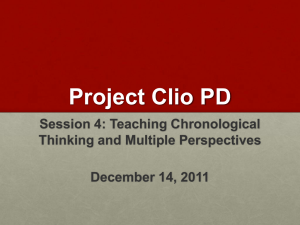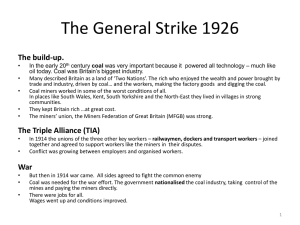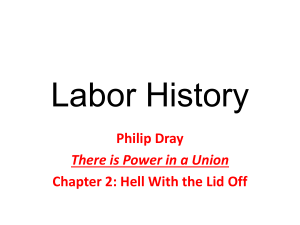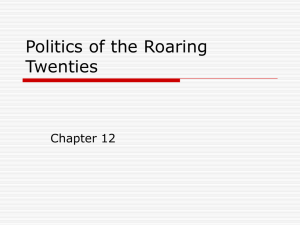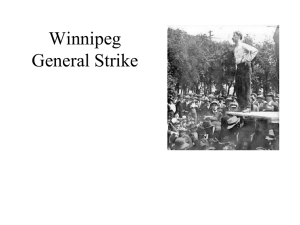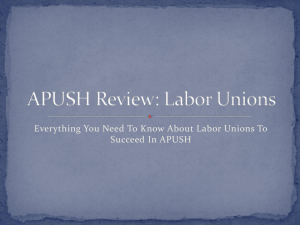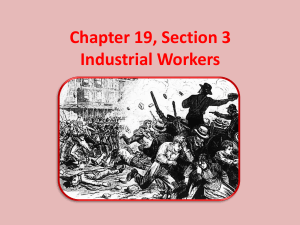Labor of Sorrow The Ludlow Massacre
advertisement
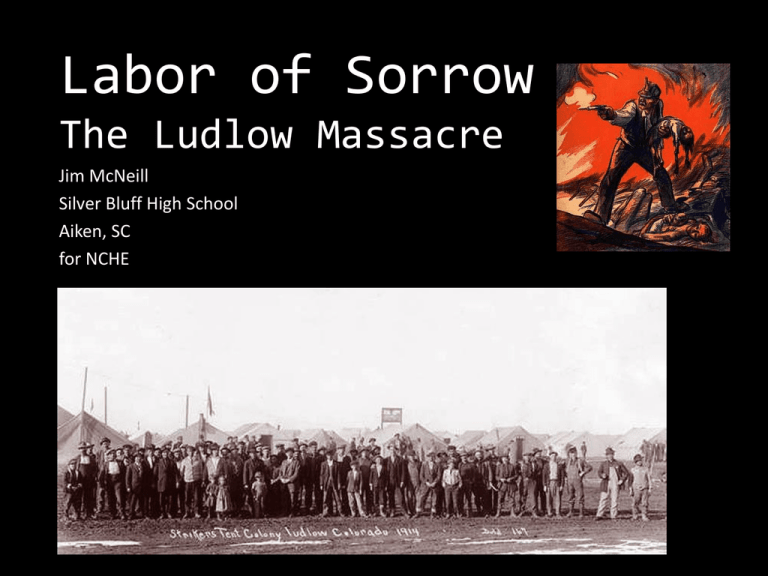
Labor of Sorrow The Ludlow Massacre Jim McNeill Silver Bluff High School Aiken, SC for NCHE Saturday, April 19, 1914 It was a beautiful Saturday along the foothills of southern Colorado. Many residents of the miner’s tent camp in Ludlow were enjoying a baseball game and the Greek population was preparing to celebrate Easter. All of that was to change. Taking a stand for their rights as workers, the miners were on strike. That strike would soon lead to tragedy… SADLY, THIS STORY HAD BEEN ACTED OUT MANY TIMES BEFORE… Lowell, MA: 1836; 1845 1846 Pennsylvania and West Virginia 1877 Chicago, Illinois - 1886 Pittsburgh, Pennsylvania: 1892 Nationwide Strike: 1894 Pennsylvania: 1902 Colorado: 1902 - 1904 New York: 1909 Lawrence, Massachusetts: 1912 Background The first decade of the 1900s witnessed thousands of European and Asiatic immigrants coming into southern Colorado. The coming of these immigrants radically changed the work force. At about the time the immigrants began arriving, the United Mine Workers union was involved in an effort to unionize the western states miners. Labor leaders began voicing dissatisfaction with how coal companies were handling the immigrant influx and initiated a concerted effort to unionize this new work force. Union officials soon learned, however, that coal companies would provide stubborn opposition to unionizing efforts. Unionizing efforts were severely hampered because of language barriers existing among immigrant miners. Adding to these problems, miners remained cautious; for in many instances, those who chose to support union movements found themselves being dismissed from their jobs. United Mine Workers' union officials eventually broke down most barriers associated with the miners, but continued to face opposition from coal company officials. • http://www.santafetrailscenicandhistoricbyway.org/ludlow.html Setting A temporary tent camp constructed for striking coal miners and their families located near the railroad depot of Ludlow in southern Colorado http://www.pbase.com/fletcher_hill/image/85933194 THE PLAYERS IN OUR STORY The miners and their families Approximately 1200 individuals were camped in a tent city in Ludlow, Colorado. The majority of the residents were foreign born miners, their wives and children. They had been evicted from their company owned homes when the coal strike began in September of 1913. The Company The Colorado Fuel and Iron Company (CF&I) was a large steel concern. By 1903, it was largely owned and controlled by John D. Rockefeller and Jay Gould's financial heirs. It also controlled several coal mining interests which totaled approximately 1/3 of all coal mining industry in the state. The National Guard The National Guard was called out by the governor of Colorado to quell disturbances, relating to the strike. They were to also protect strike breakers as they traveled to the mines to work. They were given the task to remain impartial in their treatment of all involved in the strike. The Baldwin-Felts Detective Agency The Baldwin-Felts detective agency was based out of Roanoke, Virginia. The BaldwinFelts firm built a reputation for being ruthless, vengeful and very effective at whatever they did, whether the job called for evicting a group of striking coal miners from their companyowned houses or tracking down a desperate band of outlaws. But that was out in the field. On the home front, the agency’s two owners, William G. Baldwin and Thomas L. Felts, were known as fine upstanding citizens, doers of great charitable deeds, respectable businessmen. Both were involved in banking. Felts even served two terms as a state senator. http://www.theroanoker.com/favoritearticles/gunsthugs.cfm. The United Mine Workers of America The UMWA made its first appearance in the Western States in 1900 with a strike in Gallup, New Mexico. In 1903, the UMWA led a strike in the Colorado coalfields. This strike was successful in the Northern Field, around Louisville and Boulder, but failed in the South. In 1910, the Northern operators refused to renew the contract and the miners struck for the next 3 years. In September 1913 the UMWA, which had secretly been organizing the Southern Field, announced a strike there when the operators would not meet a list of seven demands. http://www.du.edu/ludlow/cfphoto.html http://www.takver.com/history/lh_gifs/secsoc03.htm Mother Jones Born Mary Harris in Ireland, raised in Canada, a teacher in Michigan and a dressmaker in Chicago, she married George Jones in 1861 and they had four children. George Jones and all four children died in a yellow fever epidemic in Memphis, Tennessee, in 1867. Mary Harris Jones then moved to Chicago, where she became a dressmaker. She lost her home, shop and belongings in the Chicago Fire. A gradually growing interest in labor union issues and in radical politics led her to become active by her late 50s as Mother Jones, white-haired radical labor organizer. Mother Jones worked mainly with the United Mine Workers, where, among other activities, she often organized http://womenshistory.about.com/od/motherjones/p/mother_jones.htm strikers' wives. http://www.kentlaw.edu/ilhs/majones.htm What were the miners’ demands that forced the strike? 1. Recognition of the union 2. A 10% increase in wages on the tonnage rates for mined coal 3. An eight-hour work day 4. Payment for “dead work” – work required of the miners that wasn’t specifically the mining of coal 5. The right to elect their own check – weightman; the person responsible for weighing the amount of coal that was mined 6. The right to trade in any store, to choose their own boarding places, and choose their own doctors 7. Enforcement of Colorado mining laws and abolition of the company system A The coal companies refused and… approximately 90% of the workforce struck, 10-12,000 miners and their families. Those who lived in the camps were evicted, and on September 23rd the striker families hauled their possessions through rain and snow out of the canyons to about a dozen sites rented in advance by the UMWA to house them. The UMWA supplied tents and ovens, and organized the strikers into the tent colonies. The colonies were located at strategic spots covering the entrances to the canyons, in order to intercept strikebreakers. Ludlow, with about 200 tents holding 1,200 miners and their families, was the largest of these colonies http://www.du.edu/ludlow/cfhist2.html B http://lcweb2.loc.gov http://www.du.edu/ludlow/gallery1.html The mine operators reacted quickly… • Strike breakers were brought in…the Baldwin-Felts Company was brought in…and a campaign of harassment against the striking miners began. http://www.du.edu/ludlow/gallery2.html On October 28, 1913, Colorado Governor Ammons called out the National Guard to maintain order. The militia commander, General Chase, suspended habeas corpus in the strike zone, conducted mass jailing of strikers, and led a cavalry charge against a parade of striker women in Trinidad who were protesting the imprisonment of Mother Jones by General Chase. Mother Jones had arrived in the town of Trinidad by train to support the striking miners. C http://www.du.edu/ludlow/gall2c.html http://lcweb2.loc.gov The strike continued through the winter. http://lcweb2.loc.gov/cgi-bin/query/r?ammem/AMALL:@field(NUMBER+@band(codhawp 10060480)) On March 10th the body of a strike-breaker was found near railroad tracks near the Forbes tents and the National Guard’s General Chase ordered the colony to be destroyed. The strike was reaching a climax, and National Guardsmen were ordered to evict the remaining tent colonies around the mines, despite them being on private property leased by the UMWA. http://libcom.org/history/1914-the-ludlow-massacre Hostilities continued to escalate… On April 19, 1914… the baseball game was almost over when down out of the hills, where these strikers had lived in hovels like hogs, had been robbed of their coal, had been deprived of their political, industrial and religious liberty, had been driven into unsafe mines to be slaughtered, came the gunmen of industry, the hired murderers of Sunday school teacher and "philanthropist' John D. Rockefeller, Jr. There were five of these gunmen on horseback and armed with high- power rifles. They came to break up the baseball game. But they realized that even high-powered rifles and machine guns trained on the baseball diamond from the hills might not be able to combat the crowd of fans, and they started away chagrined. Some of the strikers' wives and children laughed at these imported assassins who were too cowardly to carry out their purpose. "Oh, that's all right; have your fun today; we'll have our roast tomorrow," said one of the gunmen, and they rode away. https://pantherfile.uwm.edu/mgordon/www/course/448-440/fink.htm On Sunday, April 20… at about 9:00 AM gunfire broke out at the colony. The exact circumstances are uncertain. Those miners who were armed (we don't know how many this was) took positions in a railway cut and in prepared foxholes to draw fire away from the colony. The militia sprayed the tent colony with machinegun and rifle fire. http://www.du.edu/ludlow/cfhist3.html D http://www.du.edu/ludlow/cfhist3.html By 7:00 p.m., the tent colony was in flames and the militia was looting the colony. The leader of the Greeks in the colony, Louis Tikas, and two other miners were captured and at some point shot and killed by the militia. After being shot in the head, miner Charles Costa died singing “Union Forever.” The known fatalities at the end of the day were 25 people, including three militiamen, one uninvolved passerby, and 11 children. E, F http://www.du.edu/ludlow/cfhist3.html http://www.kued.org/productions/fire/photos_stories/massacre.html Under the command of Karl Linderfelt, the militia doused the tents in Ludlow with kerosene and set them on fire. They also looted the camp. During the battle, four women and ten children took refuge in a pit dug beneath a tent. All but two, Mary Petrucci and Alcarita Pedregone, suffocated when the tent above them was burned. The dead included Mary Petrucci's three children and Alcarita Pedregone's two children. G By the next morning, the camp was gone. Word of the massacre spread and a call was sent for all miners to rise up against the mining companies. This resulted in the Ten-Days War . During that ten day period, miners in southern Colorado fought against mine guards and militia from Trinidad to Walsenberg. H The Ten-Day War ended when Governor Ammons requested federal assistance. President Wilson ordered troops to the area to end the fighting. http://www.du.edu/ludlow/gallery4.html Meanwhile, survivors buried their dead… http://www.du.edu/ludlow/gallery4.html and refugees tried to adapt. I http://www.du.edu/ludlow/gallery4.html What were the results of the strike? • At least 50 people were killed during the strike, massacre and Ten-Day War. • The strike dragged on until December of 1914 and the union was defeated. • Mass arrests of strikers were made with 332 indicted for murder. All charges were eventually dropped. • Only 22 National guardsmen were courtmartialed, all exonerated. • John Rockefeller Jr. engaged labor relations expert W. L. Mackenzie King to develop a plan for a series of reforms in the mines and company towns of southern Colorado. Variously known as the Colorado Industrial Plan, Colorado Plan, Industrial Representation Plan or just “Rockefeller Plan,” the reforms called for a worker grievance procedure, improvements to company towns such as construction of paved roads and recreational facilities like YMCAs, enforcement of Colorado mining laws and the election of worker representatives to serve with management on four standing committees concerned with working conditions, safety, sanitation and recreation • The Colorado Industrial Plan effectively established a company union. The Colorado Plan served as the model for many other company unions that spread across the country and by 1920 covered 1.5 million workers or about 8 percent of the workforce. http://www.cobar.org/index.cfm/ID/581/dpwfp/Historical-Foreward-and-Bibliography/ • John D. Rockefeller was excoriated by the public, press and government. J • Rockefeller’s attempt to rehabilitate his image resulted in the birth of professional public relations. K, L, M What do you think? What happened to Ludlow? • The UMWA purchased land where the tent camp stood, preserved the death pit where 11 women and children died and erected a granite monument in 1918 to honor the memories of those who died. Sadly, the monument was vandalized, but later repaired in 2005. http://www.rebelgraphics.org/ludlow.html Ludlow itself is a ghost town - victim to the end of the mines. http://www.ghosttowngallery.com/htme/ludlowco.htm http://www.rebelgraphics.org/ludlow_second_century.html Sources • • • • • • • • • • • • • • • • http://www.du.edu/ludlow/index.html http://www.pbs.org/wgbh/amex/rockefellers/sfeature/sf_8.html http://www.santafetrailscenicandhistoricbyway.org/ludlow.html http://www.woodyguthrie.org/Lyrics/Ludlow_Massacre.htm http://historymatters.gmu.edu/d/5736/ http://historymatters.gmu.edu/d/5737/ http://archaeology.about.com/cs/military/bb/ludlow.htm http://www.youtube.com/watch?v=U6kuvBnNNUs http://www.rebelgraphics.org/ludlow.html http://www.flickr.com/photos/walkadog/sets/72157616926219217/ http://www.economicexpert.com/a/Ludlow:Massacre.htm http://www.loc.gov http://www.marxists.org/history/etol/writers/eastman/works/1910s/trinid.htm http://www.ghosttowngallery.com/htme/ludlowco.htm http://www.nps.gov/history/nhl/Fall08Nominations/Ludlow%20Photos.pdf http://www.folkarchive.de/werecomi.html
